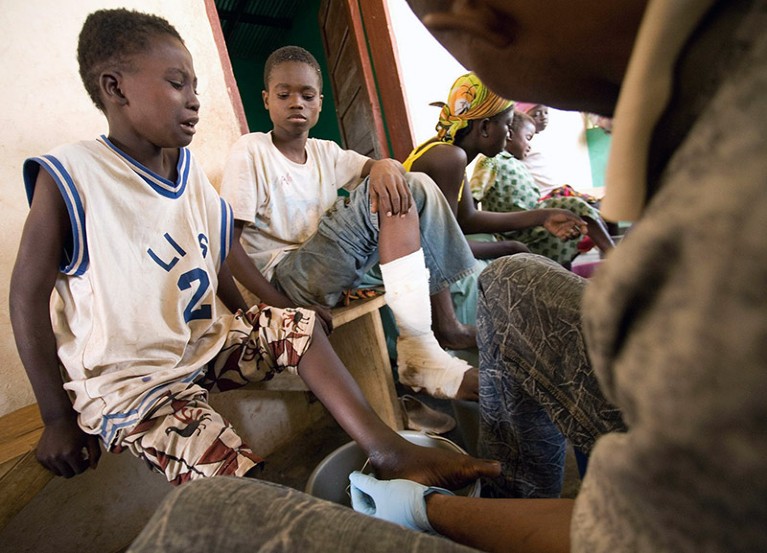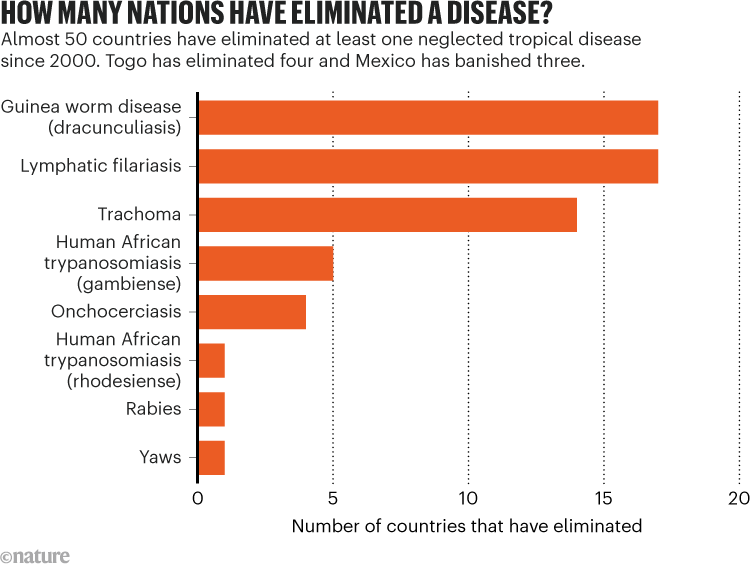
Treatment for Guinea worm disease, caused by a parasite, can be painful, but the condition has been eliminated in almost 20 countries.Credit: Olivier Asselin/AP/Shutterstock
Malawi, Vanuatu and Uganda were among the eight nations that eliminated a neglected tropical disease last year, according to a World Health Organization (WHO) report. That takes the number of countries that have done so since the late 1990s to almost 50, with 11 banishing more than one disease.
“That’s a tremendous effort,” says Francisca Mutapi, a global-health specialist at the University of Edinburgh, UK. The latest WHO report comes two years after the agency released a plan to control or eliminate neglected tropical diseases (NTDs) by 2030.
NTDs are a group of around 20 conditions that affect more than one billion people worldwide but have been largely overlooked by global health agendas. The diseases generally affect people living in impoverished communities and can be caused by bacteria, viruses, fungi, parasites or toxins.
Last year, the Democratic Republic of the Congo eliminated guinea worm disease, which is caused by a parasite, joining 16 other countries that have rid themselves of the condition. Togo, Malawi, Saudi Arabia and Vanuatu got rid of trachoma, a bacterial infection that causes blindness, and Uganda and Equatorial Guinea eliminated a type of African trypanosomiasis, or sleeping sickness, which is caused by the parasite Trypanosoma brucei.

WHO Global Report on Neglected Tropical Diseases 2023
Diseases can either be completely elimination, or be eliminated as a public-health problem, says Ibrahima Socé Fall, director of the WHO’s Department of Control of Neglected Tropical Diseases. “In every case, the outcome is exciting,” says Fall. “Neglected tropical diseases are problems that affect the poorest of the poor, so we are always excited when we see people freed from the diseases.”
Effective methods
Preventive chemotherapy has been highly effective at tackling some NTDs, namely trachoma, lymphatic filariasis (also called elephantiasis), river blindness (onchocerciasis), schistosomiasis and soil-transmitted helminthiases (diseases involving parasitic worms). Medication given at regular intervals to groups or populations treats infections and stops their spread.
Many NTDs, including schistosomiasis, are waterborne, so efforts to provide people with safe water, sanitation and hygiene — WASH — can help to eliminate them, says Mutapi. The report notes that the COVID-19 pandemic increased hand-washing efforts. Although the impact of these efforts on transmission of some NTDs is yet to be fully appreciated, it said, “it is likely to be significant”.
But the pandemic also disrupted elimination progress in many countries. Problems with supply chains limited availability of health-care supplies and restricted intervention efforts, and access to health-care facilities was reduced. Preventive chemotherapy was also affected in some places. “We really need to think and be innovative in how we would be prepared if another [pandemic] comes before we reach our goals,” says Shaden Kamhawi, the group leader for leishmaniasis at the US National Institute of Allergy and Infectious Diseases in Rockville, Maryland.
Still, she says, “any progress is good progress”. In the past decade, the number of people needing interventions for an NTD fell by 25%. Between 2020 and 2021 alone, the figure dropped by around 80 million.
Fall emphasizes the need for sustainable funding and global attention to ensure that NTDs are not further neglected. To continue the momentum of success, Mutapi agrees, elimination efforts need to be sustained to prevent reinfection. That means funding disease surveillance.
“We have to be optimistic,” says Kamhawi, but she adds that there is a long way to go. “We shouldn’t drop our guard.”

